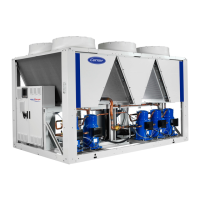
Do you have a question about the Carrier Aquasnap 30RQ 070R and is the answer not in the manual?
Guidelines for safely moving and lifting the unit using appropriate equipment and methods.
Instructions for outdoor installation, ensuring proper space, level surface, and environmental considerations.
Detailed physical characteristics including sound levels, dimensions, weight, and component data for 40R-160R models.
Explains electrical specifications such as voltage, current draw, power input, and start-up current for 040R-160R.
Specifies requirements for the unit's power supply, including voltage and phase imbalance limits.
Explains how to calculate and check voltage phase imbalance, with acceptable limits.
Provides guidance on selecting appropriate cable sizes for power connections based on unit load and installation conditions.
Defines the permissible operating conditions for air and water temperatures for the unit.
Recommendations and precautions for connecting the unit's water circuits, including analysis and treatment.
Schematic diagrams and key components for hydraulic circuits with and without a hydraulic module.
Method for adjusting water flow rate by controlling pressure drop to match design specifications.
How to control flow rate using variable speed pumps based on pressure differential setpoints.
How to control flow rate using variable speed pumps based on temperature difference setpoints.
Charts showing available static pressure for different flow rates and unit sizes with hydraulic modules.
Comprehensive checklist of installation, safety, and component checks before initial unit start-up.
Steps and precautions for the professional commissioning and start-up of the unit.
Key checks for compressors, hydraulics, and refrigerant charge during start-up.
Comprehensive tables listing available options, their descriptions, advantages, and applicability.
How units operate with free cooling drycoolers for energy savings, including control algorithms.
Explains the system's optimisation of drycooler fans and water loop flow for energy savings.
Simple maintenance procedures that can be performed by the user, including visual checks and cleaning.
Maintenance requiring specific expertise, covering electrical, hydraulic, and mechanical systems.
High-level maintenance requiring manufacturer expertise, including component replacement and refrigerant handling.
Table specifying torque values for tightening various electrical connections for safety and reliability.
Checklist for shipping damage, installation level, power supply, wiring, and connections.
Checklist for air handling units, valves, piping, and pump operation.
Checklist items related to pump cabling, oil level, leak checks, and voltage imbalance.
Checks for water loop volume, corrosion inhibitor, frost protection, and piping.
Procedure to check evaporator pressure drop and determine flow rate.
Fields to record stable operating temperatures and pressures for compressor circuits and water loops.












